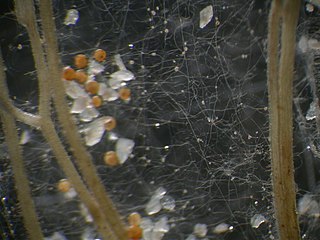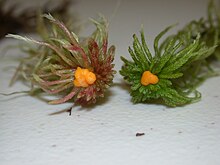
The Hypocreales are an order of fungi within the class Sordariomycetes. In 2008, it was estimated that it contained some 237 genera, and 2647 species in seven families. Since then, a considerable number of further taxa have been identified, including an additional family, the Stachybotryaceae. Wijayawardene et al. in 2020 added more families and genera to the order. According to the Catalog of Life, As of April 2021 the Hypocreales contains 6 families, 137 genera, and 1411 species. Hyde et al. (2020a) listed 14 families under Hypocreales, while, Wijayawardene et al. (2022) accepted 15 families in the order, where Cylindriaceae was additionally added. Earlier, Hyde et al. (2020a) had placed Cylindriaceae in class Xylariomycetidae. Samarakoon et al. (2022) agreed. Hence, Cylindriaceae should have been excluded from Hypocreales and placed in Xylariomycetidae. Xiao et al. (2022) recently introduced a new family Polycephalomycetaceae to Hypocreales.
Spegazzinia is a genus of widely distributed mitosporic ascomycete fungi in the family Didymosphaeriaceae.As accepted by Wijayawardene et al. 2020.

Glomeromycota are one of eight currently recognized divisions within the kingdom Fungi, with approximately 230 described species. Members of the Glomeromycota form arbuscular mycorrhizas (AMs) with the thalli of bryophytes and the roots of vascular land plants. Not all species have been shown to form AMs, and one, Geosiphon pyriformis, is known not to do so. Instead, it forms an endocytobiotic association with Nostoc cyanobacteria. The majority of evidence shows that the Glomeromycota are dependent on land plants for carbon and energy, but there is recent circumstantial evidence that some species may be able to lead an independent existence. The arbuscular mycorrhizal species are terrestrial and widely distributed in soils worldwide where they form symbioses with the roots of the majority of plant species (>80%). They can also be found in wetlands, including salt-marshes, and associated with epiphytic plants.

Phanerochaete is a genus of crust fungi in the family Phanerochaetaceae.

The Amphisphaeriaceae are a family of fungi that is mainly found in parts of New Zealand, South America, Asia and parts of Europe. According to the 2007 Outline of Ascomycota, there were 41 genera placed within the family, although the position of 13 of those genera is uncertain. The 2020 Outline of Fungi and fungus-like taxa severely reduced the family to 4 members.

Mucoromycotina is a subphylum of uncertain placement in Fungi. It was considered part of the phylum Zygomycota, but recent phylogenetic studies have shown that it was polyphyletic and thus split into several groups, it is now thought to be a paraphyletic grouping. Mucoromycotina is currently composed of 3 orders, 61 genera, and 325 species. Some common characteristics seen throughout the species include: development of coenocytic mycelium, saprotrophic lifestyles, and filamentous.
Didymosphaerella is a genus of fungi in the family Didymosphaeriaceae. It was originally placed in family Montagnulaceae, until that family was dissolved.

Catinella is a genus of fungi in the class Dothideomycetes. It is placed in the monotypic family of Catinellaceae in the monotypic order of Catinellales.
Navicella is a genus of fungi, that had been placed in the family Massariaceae. According to Wijayawardene et al. 2020, it is now placed in the Melanommataceae family.
Aulographina is a genus of fungi. It was placed in the Asterinaceae family. then later placed in the Teratosphaeriaceae family.
Spinulosphaeria is a genus of fungi in the Sordariomycetes class of the Ascomycota. It was placed in 2020, within the Order Coronophorales and in the family of Chaetosphaerellaceae.
Tengiomyces is a genus of fungi in the Coronophorales order of the Ascomycota. The relationship of this taxon to other taxa within the Sordariomycetes class is unknown, and it has not yet been placed with certainty into any family. This is a monotypic genus, containing the single species Tengiomyces indicus.
Apodospora is a genus of fungi, formerly within the Lasiosphaeriaceae family. As on 2020, it was placed in the Bombardiaceae family.
Gabarnaudia is a genus of anamorphic fungi that was placed in the family Ceratocystidaceae, until phylogenetic analysis by Hausner and Reid (2004) and De Beer et al. (2013a) showed that Gabarnaudia fimicolaG. betae and G. humicola clustered within genus Sphaeronaemella.

Endogone is a genus of fungi in the family Endogonaceae of the division Zygomycota. The genus has a widespread distribution, especially in temperate regions, and contains about 20 species.

Entomophthoromycota is a division of kingdom fungi. In 2007, it was placed at the taxonomic rank of subphylum in the most recent revision of the entire fungus kingdom. In 2012, it was raised to the rank of phylum as "Entomophthoromycota" in a scientific paper by Richard A. Humber 2012. Divided into three classes and six families, it contains over 250 species that are mostly arthropod pathogens or soil- and litter-borne saprobes.
Calcarisporiellaceae is a family of fungi within the subkingdom Mucoromycota. It is the only family in the order Calcarisporiellales, class Calcarisporiellomycetes, subphylum Calcarisporiellomycotina and phylum Calcarisporiellomycota. It contains two known genera, Calcarisporiella and Echinochlamydosporium. The two genera each have one species.
Fuscosporellales is an order of fungi within the phylum of Ascomycota and in the class Sordariomycetes and subdivision of Pezizomycotina.
Pisorisporiales is an order of fungi within the phylum of Ascomycota and in the class Sordariomycetes and subdivision of Pezizomycotina and also its own subclass Pisorisporiomycetidae.

Coniothyriaceae is a family of ascomycetous marine based fungi within the order of Pleosporales in the subclass Pleosporomycetidae and within the class Dothideomycetes. They are pathogenic or they can be saprobic on dead branches. They are generally a anamorphic species.









